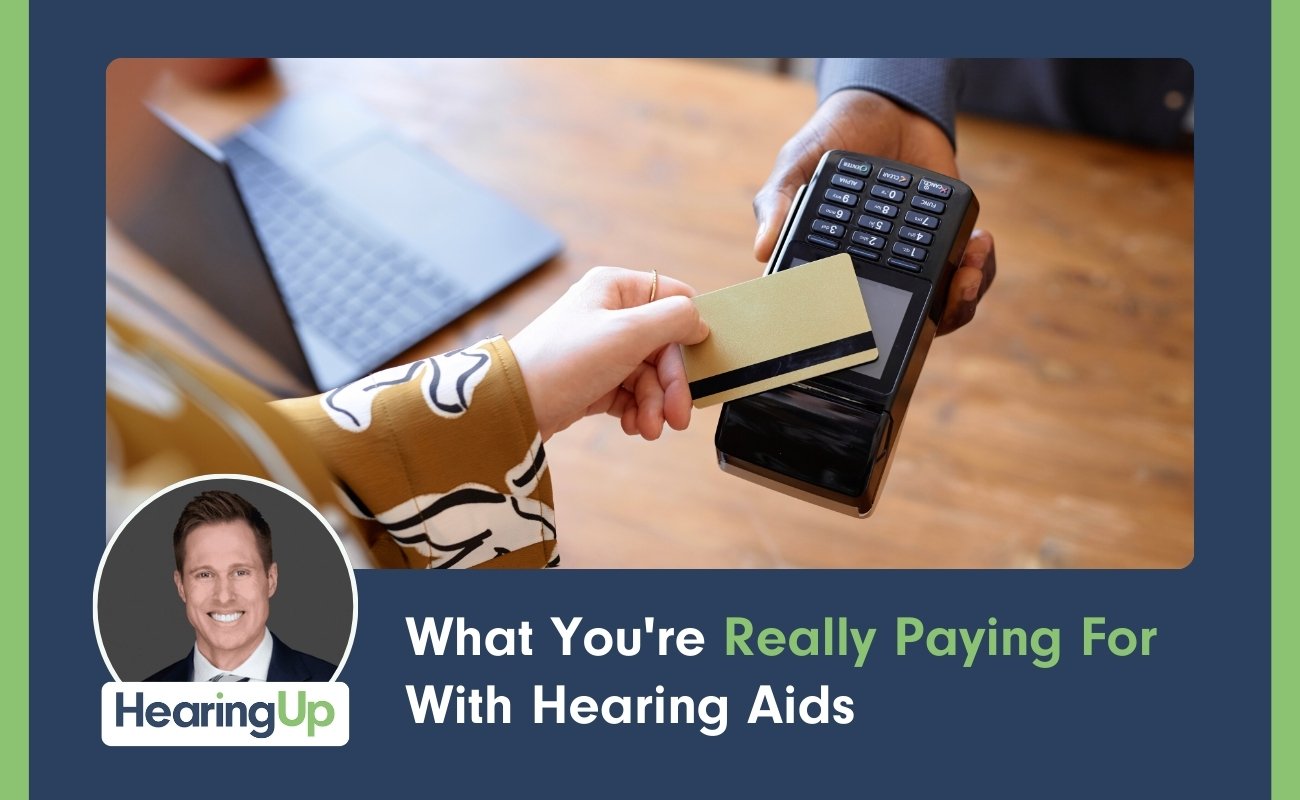You know, this video might get me in a lot of trouble, but quite frankly, I don't give a sh. Hi guys. Cliff Olson, Dr of Audiology and founder of Applied Hearing Solutions in Phoenix, Arizona. And in this video, I'm gonna tell you the truth about hearing aid Bluetooth connectivity issues, coming up!
Wireless Bluetooth connectivity inside of hearing aids has been around for a while. Up until 2014 though, this connectivity required the use of a neck loop, so something that you would literally put around your neck. That device would connect using Bluetooth Classic to a smart device that would send audio directly into that neck loop and convert it using Nearfield Magnetic Induction, which is a signal that could actually communicate with your hearing aids. While this did work to stream audio from a Bluetooth device into an individual's hearing aids, these neck loops were not that reliable, and the signal quality was not as good. Then all of a sudden in 2014, we saw the release of the first made for iPhone hearing aids that could directly take a signal from an iPhone and stream it into both of your ears at the same time. This was an absolute game changer because it removed the necessity to have this neck loop that was just another accessory that you would have to fiddle with.
And since that time, we've also had technology developed to where you can stream from Android devices into both of your ears as well. Not only did this Bluetooth technology allow you to stream things like audiobooks, podcast, YouTube videos, music, and even phone calls directly into both of your ears, but it dramatically improved the quality of the signal as well. However, there was, and still is a major problem with this Bluetooth technology, but before I tell you exactly what that problem is, if you could do me a huge favor and click the like button, it lets me know that you want me to make more videos just like this one. And while you're at it, if you have not yet hit that subscribe button with notification Bell, go ahead and do that as well, because that ensures that you never miss one of my newly released videos and I release multiple new videos every single week.
That being said, I really appreciate it and I'll take a look at what the problem is, and the problem is cellphone companies, you see, having a stable wireless connection between your smart device and your hearing aids requires two things. It requires hardware that is actually working, and it requires software that makes it compatible. The hardware part is common sense. If you have a faulty antenna inside of your hearing aids or inside of your smart device, you're not gonna be able to transmit a signal. These physical issues regarding the antennas are extremely rare. In fact, I only see them maybe one or two times in an entire year inside of my clinic. The more common issue that occurs is software related, specifically when cell phone manufacturers release an update to their software inside of their smart devices, that happens to have a negative effect on Bluetooth connectivity with both hearing aids and other Bluetooth devices.
The fact is, the majority of the time that you are having Bluetooth connectivity issues, it has nothing to do with the hearing aids, and it has everything to do with the tablets and smartphones that you're pairing them with. Since Made for iPhone hearing aid technology came out around 10 years ago, the vast majority of Bluetooth connectivity issues had to do when Apple pushed out an iOS update. However, these problems are not 100% isolated to these iOS updates. You also see issues with updates that are coming through with Android devices since there are now the Bluetooth classic protocols and ASHA Bluetooth protocols inside of hearing aids. Of course, when the Bluetooth stops working and you can no longer stream audio directly into both of your hearing aids, your natural inclination is, well, it must be the hearing aids right?...WRONG! Unless you manage to destroy the Bluetooth antennas inside of your hearing aids by doing something like, I don't know, throwing your hearing aids down on the ground, it is much more likely that the software updates that are automatically happening inside of your smart devices are messing with the Bluetooth connection.
And since most people have these set on auto update, you don't even know when this issue's gonna happen. The worst part is when you happen to call the manufacturer of your phone or your tablet and say, Hey, what's going on with your Bluetooth connectivity? They're gonna tell you that they have no idea what you're talking about making you think that it's your hearing aids instead. Now, these problems with Bluetooth often result in you needing to reboot your hearing aids constantly needing to reboot your smartphone or tablet, constantly needing to repair your hearing aids to your smart devices after rebooting having a higher rate of hearing aid battery drain if your hearing aids are connected to a smart device intermittency while making phone calls or streaming music or the perception of static noise when streaming audio as well. These issues caused by cell phone manufacturer updates make hearing aid manufacturers have to scramble to come up with a firmware update to fix the glitch that occurred due to the cell phone companies.
Fortunately, hearing aid manufacturers are much quicker at identifying and solving these problems than these really large cell phone companies are. In the meantime, virtually everybody who pushed through these updates through their smart devices are gonna have issues with Bluetooth connectivity, and some of them will go back to what they were like pre 2014 when they had no Bluetooth connectivity. Fortunately, these issues are typically short-lived, so just take a deep breath and know that the hearing aid manufacturers are on it, and in the meantime, you can often get some assistance from your hearing care professional. If you're lucky, your audiology clinic will have some support staff on hand for you to get immediate assistance with any Bluetooth connectivity issues that you may be having. In my clinic, we have to employ a full-time audiology assistant, and half of her time is spent actually dealing with Bluetooth connectivity issues on a daily basis and virtually every time that I ask her what the issue is with the Bluetooth connectivity issue, the same response is always, it had to do with their cell phone not to do with their hearing aids.
Now, I know it's sounding like all I'm doing is complaining about Bluetooth connectivity, but the fact of the matter is is that Bluetooth has dramatically improved the lives of tens of thousands of hearing aid users. Anytime that you can take audio and directly stream it into both of your ears at your prescriptive levels, you are going to be hearing better hands down guaranteed. It is improved the ability of individuals to communicate with family and friends better over the telephone, and it has also restored the ability to get music appreciation back. Even though Bluetooth is sometimes a huge pain in the butt, I would never want to go back to the way that it was when we didn't have Bluetooth available. And just remember, every single time that you have a Bluetooth related issue, it often gets resolved very quickly by your hearing care professional and an update from the hearing aid manufacturers, and oftentimes you don't experience any more of these issues for months or years.
So the next time that you experience some Bluetooth connectivity issues with your hearing aids, just remember that the problem is going to be short-lived and once there's a fix in place, it will likely be a while before the problem occurs again. But as sure as I know that the sun will come up tomorrow if you use Bluetooth compatible hearing aids, at some point you will have connectivity issues, but at the end of the day, it is still totally worth it. That's it for this video. If you have any questions, leave them in the comment section below. If you like the video, please share it. If you wanna see more videos just like this one, go ahead and hit that subscribe button. Also, feel free to check out my website, HearingUp.com.
You know, this video might get me in a lot of trouble, but quite frankly, I don't give a sh. Hi guys. Cliff Olson, Dr of Audiology and founder of Applied Hearing Solutions in Phoenix, Arizona. And in this video, I'm gonna tell you the truth about hearing aid Bluetooth connectivity issues, coming up!
Wireless Bluetooth connectivity inside of hearing aids has been around for a while. Up until 2014 though, this connectivity required the use of a neck loop, so something that you would literally put around your neck. That device would connect using Bluetooth Classic to a smart device that would send audio directly into that neck loop and convert it using Nearfield Magnetic Induction, which is a signal that could actually communicate with your hearing aids. While this did work to stream audio from a Bluetooth device into an individual's hearing aids, these neck loops were not that reliable, and the signal quality was not as good. Then all of a sudden in 2014, we saw the release of the first made for iPhone hearing aids that could directly take a signal from an iPhone and stream it into both of your ears at the same time. This was an absolute game changer because it removed the necessity to have this neck loop that was just another accessory that you would have to fiddle with.
And since that time, we've also had technology developed to where you can stream from Android devices into both of your ears as well. Not only did this Bluetooth technology allow you to stream things like audiobooks, podcast, YouTube videos, music, and even phone calls directly into both of your ears, but it dramatically improved the quality of the signal as well. However, there was, and still is a major problem with this Bluetooth technology, but before I tell you exactly what that problem is, if you could do me a huge favor and click the like button, it lets me know that you want me to make more videos just like this one. And while you're at it, if you have not yet hit that subscribe button with notification Bell, go ahead and do that as well, because that ensures that you never miss one of my newly released videos and I release multiple new videos every single week.
That being said, I really appreciate it and I'll take a look at what the problem is, and the problem is cellphone companies, you see, having a stable wireless connection between your smart device and your hearing aids requires two things. It requires hardware that is actually working, and it requires software that makes it compatible. The hardware part is common sense. If you have a faulty antenna inside of your hearing aids or inside of your smart device, you're not gonna be able to transmit a signal. These physical issues regarding the antennas are extremely rare. In fact, I only see them maybe one or two times in an entire year inside of my clinic. The more common issue that occurs is software related, specifically when cell phone manufacturers release an update to their software inside of their smart devices, that happens to have a negative effect on Bluetooth connectivity with both hearing aids and other Bluetooth devices.
The fact is, the majority of the time that you are having Bluetooth connectivity issues, it has nothing to do with the hearing aids, and it has everything to do with the tablets and smartphones that you're pairing them with. Since Made for iPhone hearing aid technology came out around 10 years ago, the vast majority of Bluetooth connectivity issues had to do when Apple pushed out an iOS update. However, these problems are not 100% isolated to these iOS updates. You also see issues with updates that are coming through with Android devices since there are now the Bluetooth classic protocols and ASHA Bluetooth protocols inside of hearing aids. Of course, when the Bluetooth stops working and you can no longer stream audio directly into both of your hearing aids, your natural inclination is, well, it must be the hearing aids right?...WRONG! Unless you manage to destroy the Bluetooth antennas inside of your hearing aids by doing something like, I don't know, throwing your hearing aids down on the ground, it is much more likely that the software updates that are automatically happening inside of your smart devices are messing with the Bluetooth connection.
And since most people have these set on auto update, you don't even know when this issue's gonna happen. The worst part is when you happen to call the manufacturer of your phone or your tablet and say, Hey, what's going on with your Bluetooth connectivity? They're gonna tell you that they have no idea what you're talking about making you think that it's your hearing aids instead. Now, these problems with Bluetooth often result in you needing to reboot your hearing aids constantly needing to reboot your smartphone or tablet, constantly needing to repair your hearing aids to your smart devices after rebooting having a higher rate of hearing aid battery drain if your hearing aids are connected to a smart device intermittency while making phone calls or streaming music or the perception of static noise when streaming audio as well. These issues caused by cell phone manufacturer updates make hearing aid manufacturers have to scramble to come up with a firmware update to fix the glitch that occurred due to the cell phone companies.
Fortunately, hearing aid manufacturers are much quicker at identifying and solving these problems than these really large cell phone companies are. In the meantime, virtually everybody who pushed through these updates through their smart devices are gonna have issues with Bluetooth connectivity, and some of them will go back to what they were like pre 2014 when they had no Bluetooth connectivity. Fortunately, these issues are typically short-lived, so just take a deep breath and know that the hearing aid manufacturers are on it, and in the meantime, you can often get some assistance from your hearing care professional. If you're lucky, your audiology clinic will have some support staff on hand for you to get immediate assistance with any Bluetooth connectivity issues that you may be having. In my clinic, we have to employ a full-time audiology assistant, and half of her time is spent actually dealing with Bluetooth connectivity issues on a daily basis and virtually every time that I ask her what the issue is with the Bluetooth connectivity issue, the same response is always, it had to do with their cell phone not to do with their hearing aids.
Now, I know it's sounding like all I'm doing is complaining about Bluetooth connectivity, but the fact of the matter is is that Bluetooth has dramatically improved the lives of tens of thousands of hearing aid users. Anytime that you can take audio and directly stream it into both of your ears at your prescriptive levels, you are going to be hearing better hands down guaranteed. It is improved the ability of individuals to communicate with family and friends better over the telephone, and it has also restored the ability to get music appreciation back. Even though Bluetooth is sometimes a huge pain in the butt, I would never want to go back to the way that it was when we didn't have Bluetooth available. And just remember, every single time that you have a Bluetooth related issue, it often gets resolved very quickly by your hearing care professional and an update from the hearing aid manufacturers, and oftentimes you don't experience any more of these issues for months or years.
So the next time that you experience some Bluetooth connectivity issues with your hearing aids, just remember that the problem is going to be short-lived and once there's a fix in place, it will likely be a while before the problem occurs again. But as sure as I know that the sun will come up tomorrow if you use Bluetooth compatible hearing aids, at some point you will have connectivity issues, but at the end of the day, it is still totally worth it. That's it for this video. If you have any questions, leave them in the comment section below. If you like the video, please share it. If you wanna see more videos just like this one, go ahead and hit that subscribe button. Also, feel free to check out my website, HearingUp.com.

Phonak Virto Infinio custom aids offer comfort and discretion but face limits in complex listening versus behind-the-ear models.
Read More
Three methods confirm hearing aid performance: test box for specs, Real Ear Measurement for accuracy, and outcome assessments for effectiveness.
Read More
LACE AI Pro uses AI to deliver personalized auditory training, boosting brain processing skills beyond what hearing aids alone can provide.
Read More
Hearing aid costs cover technology, expert services like Real Ear Measurement and fitting, ongoing support, and admin fees—justifying the investment.
Read More
Dr. Cliff provides a comprehensive tutorial on the ReSound Smart App, covering its features, customization options, and advanced capabilities for hearing aid users.
Read MoreDr. Cliff reviews the Oticon OWN SI custom hearing aids, examining their invisible design, Deep Neural Network 2.0 technology, and performance trade-offs.
Read More